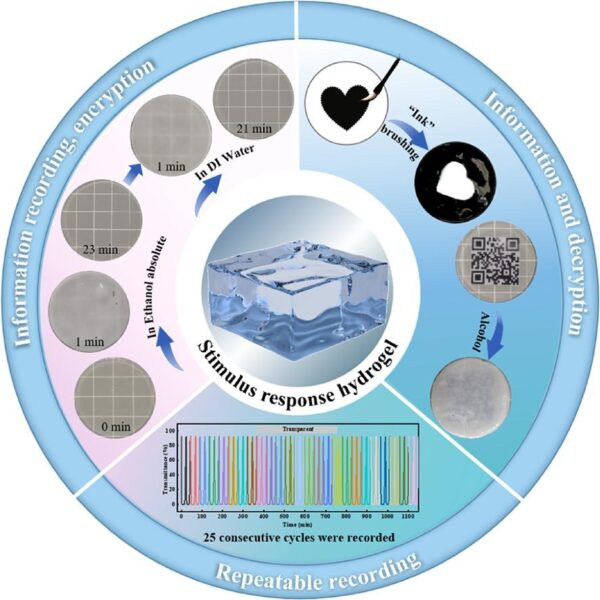Trends in Smart Hydrogels: Ready for Real-World Applications

Smart hydrogels are evolving from lab concepts to real-world tools, showing trends in biomedicine, robotics, and sustainable applications.
These hydrogels respond reliably to stimuli like temperature, pH, or solvents, enabling reversible transformations across diagnostics, packaging, and robotics. Because they operate at the interface of adaptability and precision, researchers are designing hydrogel systems that advance sustainability and meet demanding technical specifications.
You can also read: Bioinspired Hydrogels in Clean Energy and Hydrogen Generation
PPNS Hydrogel: Visual Patterning with Repeatable Precision
Using the ethanol-driven response, the PPNS hydrogel can display QR codes, images, or encryption patterns which become visible upon activation. These patterns then disappear entirely when rinsed with water, providing a functional example of information concealment and erasure. The resolution remains sharp, and contrast is maintained across cycles, allowing it to function as a temporary and programmable display medium.
Because this method requires no electronics or external energy input, it presents an eco-friendly alternative to traditional displays or printed codes. Moreover, it supports secure encryption practices without depending on software or hardware, which adds another layer of tamper-resistance and privacy. Xue et al. (2024) demonstrated that the hydrogel can be repeatedly cycled over 25 times without degrading mechanical performance or optical resolution. Water restores full transparency, resetting the pattern and enabling scalable reuse for packaging, anti-counterfeiting, and smart labeling.

Due to their responsive and dynamic nature of PPNS hydrogels are positions them as promising candidates for use as innovative information storage platforms. Courtesy of A stimuli-responsive hydrogel for reversible information storage, encryption and decryption.
Biomedical Hydrogels: Responsive Systems for Tissue and Therapy
In biomedical contexts, researchers are tailoring hydrogels that mimic soft tissue and respond precisely to biological and environmental changes. Neumann and Vermonden (2023) described hydrogels that emulate extracellular matrix behavior and adapt in real time to physiological signals. These materials support tissue engineering applications, including 4D bioprinting and site-specific drug release mechanisms. They respond to internal cues such as temperature shifts, enzymatic activity, or pH changes by modifying structure or swelling properties. Moreover, El-Husseiny et al. (2023) emphasized PVA-based hydrogels for use in wound healing, cardiac tissue repair, and controlled therapeutic delivery. Because they combine biocompatibility with targeted functionality, these systems meet current demands for minimally invasive and programmable biomedical technologies.
Design and Engineering: Balancing Sensitivity with Structural Integrity
To function effectively in real-world systems, responsive hydrogels must combine sensory accuracy with mechanical resilience and chemical durability over time. Liang et al. (2024) reviewed engineering methods including freeze/thaw cycling, dual-network construction, and nanocomposite reinforcement to tune strength and responsiveness. These design strategies support hydrogels that stretch, self-heal, and respond to multiple stimuli without losing performance or dimensional control. As a result, such hydrogels are increasingly used in soft robotics, flexible electronics, and pressure-responsive sensors where long-term functionality is critical. Because these materials integrate physical responsiveness with design stability, they meet demands in applications where traditional polymers fall short.
Sustainable by Design
Stimuli-responsive hydrogels offer sustainable advantages through solvent-based activation, reuse cycles, and avoidance of embedded electronics or environmentally harmful additives. The PPNS hydrogel, for example, supports low-energy patterning without permanent marking, reducing waste and enabling material reuse. In healthcare, bioresorbable hydrogels lower the ecological footprint of single-use devices while maintaining strict safety and performance requirements. Because hydrogels are water-based, modular, and often derived from bio-compatible chemistries, they present a lower-impact alternative to conventional plastics in technical applications. As industries move toward greener solutions, these materials offer both ecological benefits and system-level adaptability.
